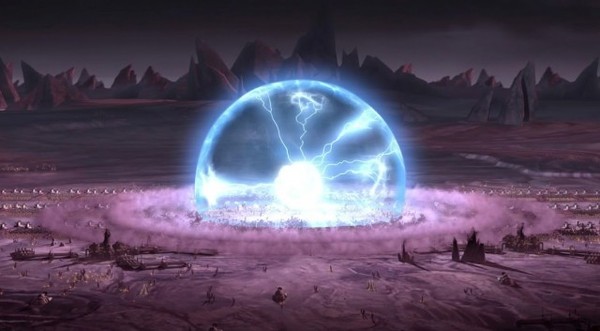-
세상을 원시시대로 되돌리는 무기: EMP폭탄‘E-폭탄’이 터질 때 발생하는 전자기 펄스가 안테나와 전력선을 타고 이동해
민간, 군사용 가리지 않고 수백m 내의 전자장치를 모두 파괴
김필재앨빈 토플러는 《전쟁과 反전쟁’(War And Anti-War)》에서 스텔스 폭격기가 한반도 핵시설 3개소를 공격했는데, 사망자는 없고 核기폭장치 가까이에서 근무하는 기술요원이 가벼운 화상을 입었다는 내용을 기술한 적이 있다.구체적으로 核시설의 기폭장치 전자 구성품들이 용해됐는데, 이것은 B-2 스텔스 폭격기로부터 발사된 마이크로웨이브 공격을 받은 것이었다고 토플러는 말했다.이처럼 전자기 펄스(EMP: Electromagnetic Pulse)를 발생시켜 사람에게는 피해를 주지 않고 상대방의 전자 장비를 무력화하는 신종 무기를 ‘E-폭탄’(E-Bomb=EMP폭탄)이라고 한다. 유사시 ‘E-폭탄’이 도시에서 폭발하면 텔레비전, 형광등, 자동차, 컴퓨터, 휴대전화 등 반도체로 작동하는 전자기기는 모두 망가져 100년 전의 세상으로 되돌아간다.지하 깊은 곳에 위치한 벙커일지라도 전자폭탄이 내뿜는 강력한 에너지가 환기 통로나 안테나를 통해 벙커로 흘러들어가 컴퓨터와 통신장비의 전자회로를 모두 녹여버린다.이 같은 현상이 발생하는 이유는 ‘E-폭탄’이 터질 때 발생하는 전자기 펄스가 안테나와 전력선을 타고 이동해 민간, 군사용 가리지 않고 수백m 내의 전자장치를 모두 파괴하기 때문이다.‘E-폭탄’의 원리는 1925년 물리학자인 콤프턴(Arthur H. Compton)이 발견했다. 고에너지 상태의 빛(광자)을 원자번호가 낮은 원자에 쏘면 전자를 방출시킨다는 것이 ‘콤프턴 효과’다.이 원리를 이용해 ‘E-폭탄’ 내부에서 초기 전자기 펄스가 만들어지고, 이를 수천만 암페어의 강한 전자기 펄스로 압축하는 것이 ‘플러스압축장치’(FCG)다.전자기펄스가 지면으로 발사돼 반도체를 강타하면 반도체는 마치 전기판에서 프라이 되듯 가열돼 파괴된다. 미국이 테러리스트들의 손에 들어가지 않을까 우려하는 것이 바로 이 FCG이다. 미국의 ‘E-폭탄’은 초전도 자석을 이용해 만든 최첨단 폭탄으로 알려져 있다.그러나 첨단기술 없이도 기본적인 FCG를 만들 수 있다. 호주의 첨단무기 전문가인 카를 콥(Carlo Kopp)은 “1940년대 기술로 ‘E-폭탄’을 만들 수 있다”고 말했다. 미국의 과학 잡지 ‘Popular Mechanics’는 ‘E-폭탄’이 400달러 정도면 만들 수 있다고 보도했던 적도 있다.1958년 미국이 태평양 상공에서 수소폭탄 실험을 했을 당시 방출된 감마선이 대기 중 산소와 질소를 때리면서 파도처럼 펄스를 만들어내 수백km 떨어진 곳에 영향을 미쳤던 적이 있다.하와이에서는 가로등이 모두 꺼졌고 호주에서도 무선항해에 지장을 받았다. 미국은 이때부터 전자기 펄스 무기를 개발했다. 인도의 경우 파키스탄이 인도의 실리콘밸리가 위치한 벵골 지방을 ‘E-폭탄’으로 공격할지도 모른다며 이에 대비해 FCG장치를 연구하기도 했다.인도군의 연구에 따르면 전자기 펄스는 폭발 뒤에도 ‘시간 지연 효과’가 나타나 15분이 지난 뒤에도 전력선이나 통신망을 따라 전기 충격이 이어졌다.김필재(조갑제닷컴) spooner1@hanmail.netNorth Korea obtains EMP weapons from Russia,
could now melt most of the electronics in AsiaBy Sebastian Anthony on November 7, 2013 at 2:38 pmHot on the heels of (reportedly) harnessing nuclear fusion and a slew of ballistic missile launches, South Korea’s intelligence agency is now reporting that Kim Jong-Un’s North Korea is developing an electromagnetic pulse (EMP) weapon. At a bare minimum, this EMP could theoretically damage electronic equipment south of the Korean DMZ. At higher power levels, a real EMP device can melt any electronic device or system within hundreds of miles. The EMP weapon would be part of North Korea’s larger cyberwarfare efforts, which have so far been mainly focused on gathering intelligence by hacking South Korean computer networks and devices.According to South Korea’s National Intelligence Service (NIS), North Korea has purchased EMP weaponry from Russia, and is now developing its own in-house version. As you’d expect, given the sensitive nature of this information, we don’t have a whole lot of details about either the Russian EMP weapon or the DPRK’s homebrew variant. We can attempt to extrapolate some details from Russia’s previous EMP tests and what we know about EMP weapons in general, though.As you probably know from The Matrix and various other action/sci-fi settings, electromagnetic pulses are the ultimate weapon against anything electronic — from telephone wires to the power grid to the computer chips that control cars, planes, and smartphones. Weaponized EMPs generally come in two forms: nuclear and non-nuclear. Non-nuclear EMPs are fairly weak (on the order of one million times weaker than their nuclear counterparts), but that’s not necessarily a bad thing if you’re just trying to knock out the electronics of a small, localized area (a military base or water pumping station, for example). At this point, we have no idea if North Korea has acquired nuclear or non-nuclear EMP tech from Russia — but as non-nuclear EMPs are pretty dull, let’s just assume the worst and assume that North Korea now has a nuclear EMP in its possession.Standard nuclear bombs, like those dropped on Hiroshima and Nagasaki, create a huge amount of gamma radiation when they explosively fission atoms. This gamma radiation ionizes — strips electrons away from — atoms in the atmosphere, creating a huge mass of free electrons. These electrons are then deflected by the Earth’s magnetic field, creating a huge electromagnetic pulse — or E1, in EMP terms. The E1 induces very high voltages in just about everything, causing wires to melt, fuses to blow, and insulators to break down and become conductors. The E1 pulse is incredibly fast — just a few nanoseconds after the nuclear detonation.There are also E2 and E3 pulses: E2 is fairly similar to lightning, and E3 is comparable to geomagnetic storms caused by solar flares (the nuke distorts Earth’s magnetic field, basically). Surge protectors generally protect against E2. E3 is hard to protect against, but its effects are generally only felt by larger electrical installations, such as power lines. The massively powerful E1 pulse — around 50,000 volts per meter, or a peak power density of 6.6 megawatts per square meter — is what knocks out the majority of your electronic infrastructure.The effects of an EMP blast in the USAA fairly small nuclear device would probably melt most of the electronics within the dark blue U area.Because the E1 pulse is generated by gamma rays striking the atmosphere, the most effective nuclear EMPs are detonated at high altitude — around 250 miles (400 km) above Earth. This allows the gamma rays to spread out before they hit the atmosphere, creating a huge area of effect. The nuclear device doesn’t even need to be that big, either — in 1962, the USA tested a 1.44-megaton nuclear EMP (Starfish Prime) above the Pacific Ocean that caused electrical damage 900 miles away in Hawaii. Kiloton-yield nukes would still be very effective as well, and to maximize the size of the EMP it’s actually better for the nuke to be plain ol’ fission, rather than a thermonuclear fission-then-fusion device. If a big EMP was detonated above the USA, the E1 burst would probably melt most of the electronics within 1,000 miles or so. (Read: 500MW from half a gram of hydrogen: The hunt for fusion power heats up.)The Soviet Union also performed some successful EMP tests in the early ’60s, fusing hundreds of miles of telephone wire and burning down a power plant (for some reason the Soviets performed the test over a populated land mass). Since then, though, as far as we know, there have been no further testing of nuclear EMPs by either the US or Russia. It’s fairly safe to assume that the world’s nuclear powers have developed advanced EMPs — the power to knock out a country’s infrastructure without frazzling millions of people is pretty awesome — but they’re impossible to test without giving away the game.Which brings us back to North Korea. It’s unlikely that Russia would give Supreme Leader Kim Jong-Un a nuclear weapon. It’s possible that North Korea has its own fission device that it’s planning to combine with older Russian/Soviet EMP tech, and then detonate it over South Korea with one of its intermediate-range BM25 Musadan ballistic missiles. But really, how North Korea obtained an EMP isn’t all that significant. It’s now been more than 50 years since the first nuclear EMP detonations. With modern tooling and technologies, creating an EMP weapon isn’t particularly hard. For me, the fact that North Korea has tested or acquired a certain weapon of mass destruction is hardly surprising — for me, it’s much more surprising that the Supreme Leader hasn’t used any of them yet.[조갑제닷컴=뉴데일리 특약]
전자기 펄스, 민간 군사용 가리지 않고 수백m 내 전자장치 모두 파괴
세상을 원시시대로 되돌리는 무기: EMP폭탄
- 김필재
입력 2014-12-14 17:30수정 2014-12-14 17:55
공유하기
기사 공유하기
김필재







